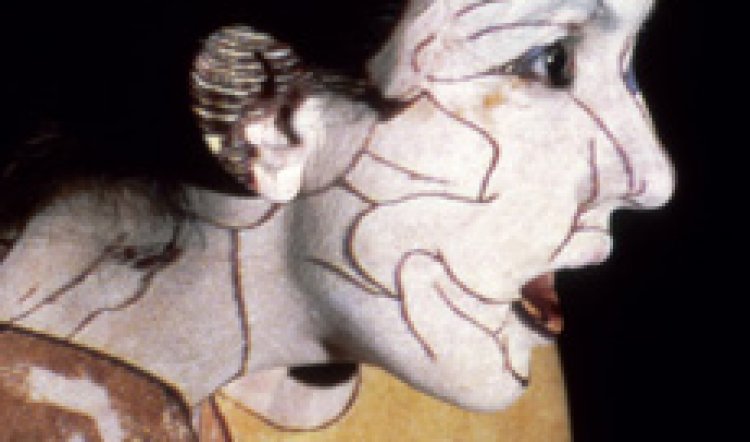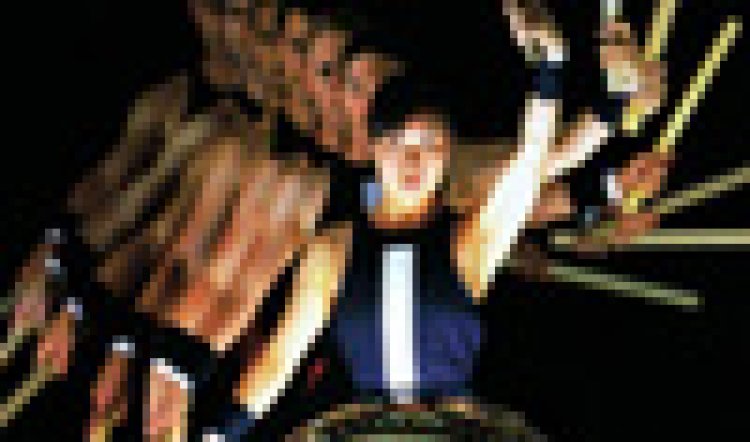
Kaidan: A Ghost Story
![]()
In essence, the collaboration between choreographer Meryl Tankard and Ian Cleworth's TaikOz drumming ensemble is sublime. The work of a soaring imagination is signalled from the opening moments of Kaidan when shakuhachi master Riley Lee, softly lit at the edge of the Drama Theatre's wide stage, plays a melancholy, autumnal refrain on the Japanese bamboo flute.
Gradually a wraithlike figure becomes visible through a scrim on which are projected fleeting images of water: sparkling, bubbling, flowing, swirling. Is the figure a fish? a ghost? imagined? a memory? or wisps of smoke from burning leaves?
The answer is yes, no, all, none and whatever the mind creates. These meditative thoughts, coupled with the hypnotic music and movement, act to draw in the audience's concentration towards the site of the action to come and away from the other, over-stimulated world of minutes before: the foyer's gossip, laughter, drinks and competition.
It is a gambit that quickly brings the audience closer to the performers, being not dissimilar to the daily rituals both the drummers and dancers go through before launching into performance. Within minutes the community is unusually united on both sides of the footlights. This is just as well, because in what follows there's a lot to concentrate on.
The Japanese story on which Kaidan is based tells of a woman whose unwilling heart leads to tragedy and revenge. She has to give up her heirloom mirror to be melted down, with the mirrors of other village women, to help repair a broken temple bell. She does not give generously, however, and the mirror will not melt. Being Japanese and consumed with guilt, she has no choice but to kill herself. But there is a sting in the tale of this apparent act of contrition: riches are promised to the villagers but greed prevails and they do not live happily ever after.
Although Tankard has chosen a strong narrative for this new work it's not allowed to get in the way of the viewer's participation nor her own powerful sense of theatre and spectacle. Rather it serves the dancers and musicians and the elements of human behaviour Tankard chooses to explore. Duality and contradiction seem to be high on her agenda: the fragility of paper fans and mutability of smoke and water are in compelling contrast to the intense physicality and discipline of the drummers whose credo, "to beat with every muscle, bone and sinew in our bodies, with an open and joyous spirit," is vividly demonstrated in their performance.
Duality also informs the choreography: long-time Tankard favourite Sarah-Jayne Howard is a glorious pale amazon whose physique lends itself equally to the graceful leaps and acrobatics of her role as the wraith-woman, while her technique and sensibility make her equally capable of the subtleties, humour and emotion which lie at the heart of Tankard's style.
Duality is also at the heart of one of the most memorable sequences in the work: a disturbing yet beautiful inversion of classical ballet's pas de deux. A black-clad male dancer manipulates the powerful yet powerless Howard in the manner of a bunraku puppet: he directs her gaze with a hand at her neck, her limbs are raised and lowered at his direction. Some moments are gentle and reflective, others are violently dismissive. The viewer can read much into the relationship between these two and none of it is happy.
[page]In another - typically Tankard - sequence, Jan Pinkerton's silvery-white moth-butterfly-insect creature floats and flies up and down a "tree" at the extreme edge of the stage while drummers occupy the foreground. When not assisting in her progress, her paper fan wings envelop her until she is a chrysalis and almost not there at all.

The shifting focus - and the almost overwhelming choice of images on offer throughout the hour and 15 minutes of Kaidan - is one of the more obvious clues of a creative mind at the top of its form. Tankard's characteristic mix of flying and tumbling with dancers involved in sequences which shift in a drum/heart beat from staccato and brief to elongated and lyrical is fully extended by the total integration of the seven members of TaikOz. Drummers and dancers are similarly clad in classic Japanese black (costume co-ordination: Judith Meschke) and are frequently indistinguishable, particularly when the dancers use fans as percussion instruments and one drummer takes to the air in a sequence of martial arts-dance moves. (Score by Cleworth, musical director Timothy Constable and TaikOz members.)
Unique to the Tankard world is the visual contribution of Regis Lansac. His extended and ambitious visuals - video, collages, still images - coupled with Trudy Dalgliesh's lighting design and Stephen Curtis's co-design of the set add thrilling dimensions to a work that defies boundaries and pigeonholes.
After working overseas for some time, including Disney and Broadway, this is Tankard's first major work in Australia since 2003's Wild Swans (for the Australian Ballet but shelved indefinitely). Nevertheless, the Sydney Festival-Sydney Opera House commission Kaidan is the most extraordinary dance-theatre-music work to be generated in this country since Nigel Jamieson's 2006 Honour Bound.
Although approaching their art from different poles, Jamieson and Tankard share several key characteristics: a consuming passion for their work, a passion for theatre and storytelling of the highest order, an unrelentingly rigorous approach to everything they do and an unwillingness to compromise. The results are works the world wants to see and that we can be proud of. Hallelujah.
Kaidan: a Ghost Story, Drama Theatre, Sydney Opera House to January 31; www.sydneyfestival.org.au or 9250 7777 or Festival Ticketek 1300 888 412
You can view a video preview of Kaidan by clicking here.



